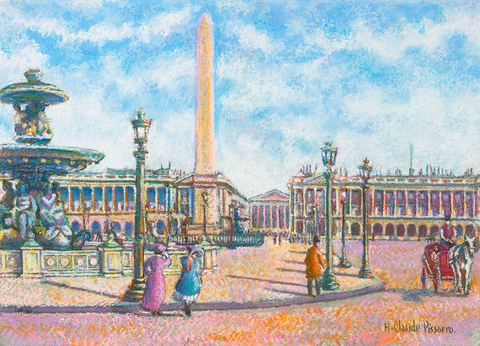
Who is who?
The first Napoleon was the brilliant military leader who had Europe quaking in its boots and Napoleon II was a toddler, his long-awaited son. Napoleon III was his nephew, a starry-eyed dreamer turned escaped convict who as emperor accomplished far more than his uncle, finally bringing the unfulfilled dreams of Napoleon I to fruition.
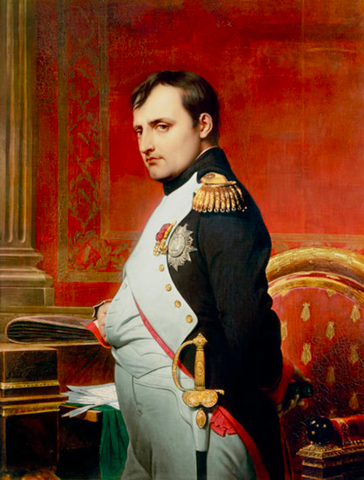

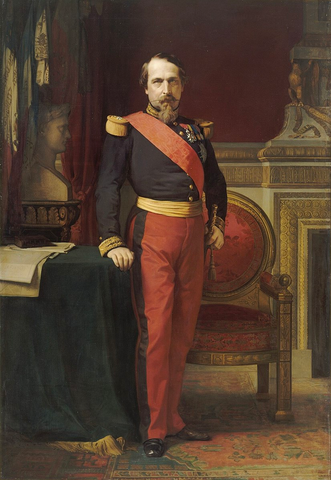
Napoleon I's Rise
The story of the three Napoleons originated with Napoleon I, who orchestrated a coup d'état in 1799 in Paris. This act concluded a tumultuous decade initiated by the French Revolution, a period marked by the fall of the monarchy, the establishment of a French republic, and the execution by guillotine of approximately 15,000 French citizens, including King Louis XVI and Queen Marie Antoinette. European monarchs had sent out troops to quash the anti-monarchy revolutionary spirit, leading to battles that France initially lost. However, after the young general Napoleon Bonaparte galloped onto the scene in 1793, France claimed victory after victory.
In the last days of the 18th century, Napoleon, freshly arrived from Egypt, his latest conquest for France — a victory that would soon evaporate — returned to Paris and overthrew the government. Called the “Coup of 18 Brumaire,” the Nov. 9, 1799, ouster, established a three-man ruling consulate. As First Consul, Napoleon reorganized the country, created a professional army, and negotiated a brief peace with France’s fiercest foe, Great Britain. Then he tweaked his title, becoming “First Consul for Life.”
The Ruler Needs an Heir
As his wife Josephine had not produced an heir, Napoleon devised an unusual succession plan in 1802: he forced his younger brother Louis to wed Hortense Beauharnais — Josephine’s daughter from a previous marriage. Though it was an unhappy union, Hortense soon gave birth to a boy. However, Louis’ siblings convinced him that the child was actually Napoleon’s.
Louis’ fears were not assuaged when Napoleon announced plans to adopt the child, Napoleon Charles. Before that plan was realized, however, the boy died from croup. Hortense bore two more sons — Napoleon-Louis and Louis-Napoleon — but by then Napoleon just wanted a son of his own; besides, paranoid Louis doubted that the boys were his.
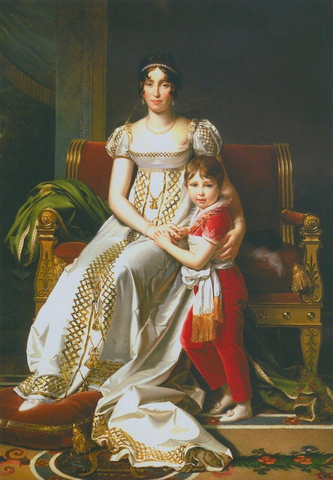
Meanwhile, Napoleon’s overseas missions were running afoul. In 1801, Britain drove the French out of Egypt, even seizing the antiquities the French had unearthed, including the Rosetta Stone.
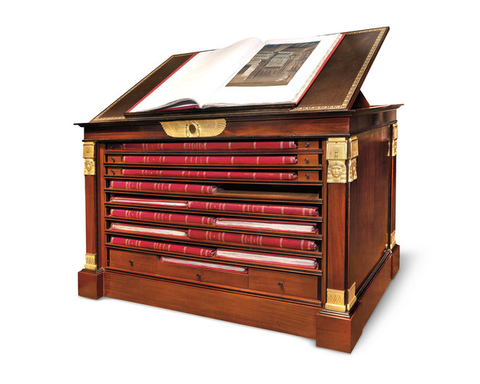
The Beginnings of the Empire
By late 1802, Napoleon’s plan to expand into the Americas began falling apart. Thanks to a secret deal with Spain negotiated in 1800, France owned the vast Louisiana Territory, including the port of New Orleans at the mouth of the Mississippi River. Napoleon wanted to claim control of the river and send French settlers into the fertile lands to its west.
With plans to launch his operation from the French colony of Saint-Domingue — today’s Haiti — he sent 20,000 troops to the Caribbean island, instructing them to subdue Saint-Domingue’s rebelling slaves and use them as soldiers in the attack on the U.S. However, yellow fever felled half of his troops and the slaves refused to fight for France.
Louisiana Purchase
What’s more, Napoleon’s war coffers were getting low. In 1803 when the U.S. offered to buy New Orleans for $10 million, Napoleon instead sold them the entire Louisiana Territory for $15 million — which is how the United States doubled in size overnight.
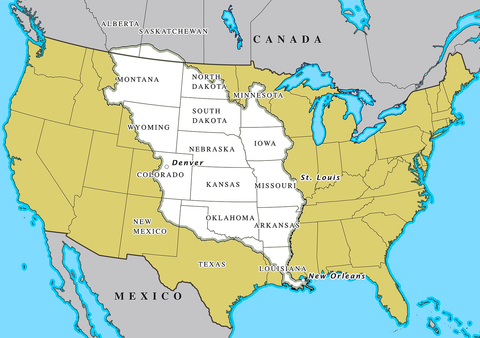
Imperial Coronation
1804 was a standout year for Napoleon: his Napoleonic Code was enacted — with new laws promising freedom of speech, freedom of religion and trial by jury. And in May, Napoleon declared himself emperor of the French people. His lavish coronation, officiated by Pope Pius VII, took place in December at Notre Dame. Now, French Emperor Napoleon Bonaparte showed who was boss, grabbing the jeweled headgear from the holy man and crowning himself.
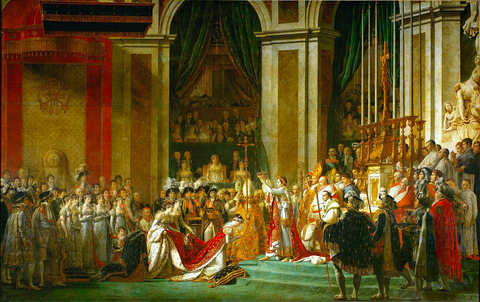
In this massive work, The Coronation of Napoleon, completed in 1807, artist Jacques-Louis David painted Napoleon’s mother, Letizia, even though in reality she was angry with Napoleon and didn’t attend. Source.
Emperor Napoleon I was hell-bent on expanding his empire — and conquering France’s rival Britain. His planned naval attack on Britain with Spain, however, was a disaster, when the British preemptively attacked their fleets off Spain, crippling the French and Spanish navies by destroying most of their vessels and making an invasion of Britain a non-starter.
Even if Britain now unquestionably ruled the seas, the French army was Europe’s mightiest force on land.
Expanding Control and Influence
Leading victorious battles in today’s Italy, Germany, Austria and beyond, the French government soon controlled most of the Continent, placing his siblings on thrones in the newly captured territories, from Naples to Holland.
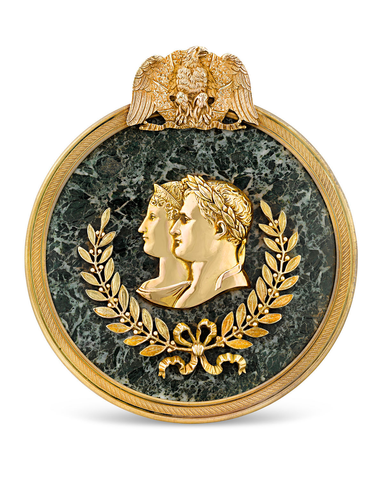
Instead, the Continental System hurt the French. Raw materials couldn’t get in, exports didn’t go out, smuggling became rampant, and across the French Empire the economy teetered. Worse, Napoleon began taking extreme actions to enforce his blockade and other decrees. Portugal refused to cut ties with Britain, so France invaded. Spain wasn’t reliable, so Napoleon invited the royal family to France, but wouldn’t let them leave, sending troops marching into Spain to install his brother Joseph as king.
Napoleon’s First Big Mistake
Those events triggered the 7-year Peninsular War, pitting France against Britain, Portugal and Spain. It bled Napoleon of so many fighters that he referred to it as “The Spanish Ulcer” and it continued throughout the rest of his reign. Angered when the pope refused to enforce his Napoleonic Code and other edicts, Napoleon had the pope kidnapped — keeping him locked up for five years.
In 1809, Napoleon annulled his marriage to Josephine and the next year wed the Austrian emperor’s daughter — Archduchess Marie-Louise. She gave birth to Napoleon François Charles Joseph, in 1811; called “The King of Rome,” he was later briefly known as Napoleon II.
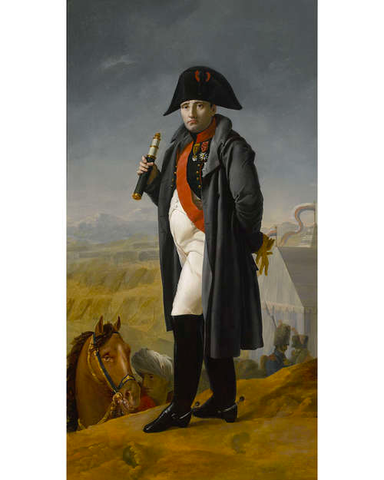
The celebrations didn’t last long. Napoleon soon turned on his former friend Russian Tsar Alexander I. Since 1807, the two had been allies. However, the Continental System devastated the Russian economy and after a few years, the tsar broke the alliance.
Russian Invasion: Expectations vs. Reality
In 1812, Napoleon invaded Russia in retaliation. Napoleon’s 6-month Russian campaign was a fiasco: the Russian forces rarely fought the French, instead burning crops and towns before they arrived. When Napoleon entered Moscow, he found it emptied and ablaze, the french soldiers weren’t equipped for the harsh winter, food ran out and soldiers abandoned him. Of the 600,000 troops Napoleon marched in with, 500,000 didn’t march out.Before being exiled to the Atlantic Island of Saint Helena, Napoleon tapped his son as successor, an idea rejected by the victors. But in the fifteen days it took to get King Louis XVIII back on the throne, Napoleon II was officially the ruler of France, although the boy, then 4, remained in Austria, unaware he was emperor.
The Empire Continues
Napoleon IIIThe Napoleonic tale could have ended right there. But it didn’t. Napoleon’s quixotic nephew Louis-Napoleon took matters into his own hands and kept trying to overthrow the French monarchy. His first laughable attempt in 1836, when he marched through Strasbourg startling citizens with calls to support him, resulted in Louis-Napoleon being banished to the U.S. by the French king.
